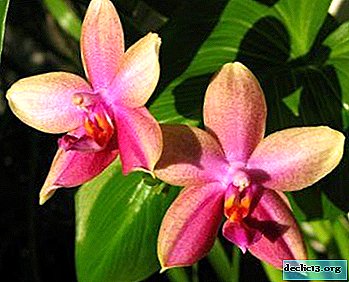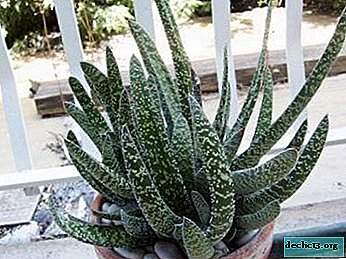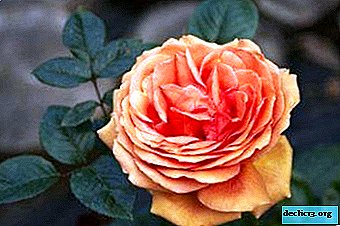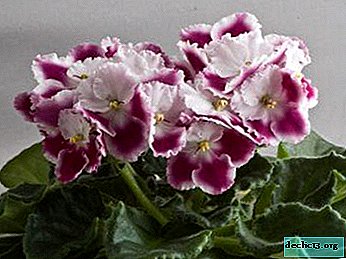Description of Liodoro Orchid, rules for plant care

Liodoro orchid is the most beautiful and beautiful phalaenopsis orchid, as well as the most beloved. It has deliciously smelling flowers in the shape of stars and various colors, with soft leaves and a silky sheen.
In addition, large peduncles. Phalaenopsis Sweet Memory Liodoro is the full name of the liodoro orchid flower. Registered by an American company in 1982.
You will learn how to care for him, transplant and breed.
Detailed description
Liodoro orchid belongs to the genus lithophytic and epiphytic plants from the orchid familythat live in Southeast Asia, northeast Australia, and the Philippines.
- The liodoro orchid has large buds, up to seven centimeters.
- Flowers have a sweet smell, mainly from pink to yellow, sometimes purple, in the form of stars.
- The color and size of flowers depends on proper care.
- Peduncles 50 centimeters. Flowers blooms on a plant up to five pieces.
- Green leaves are 25 centimeters long and 11 centimeters wide.
- Senals and petals are oval in shape and 4 centimeters long.
- The lip is triple, the size is from two centimeters to one and a half centimeters.
- The sides are straight, long.
Photo
Next, you will see a photo of Liodoro orchid:




What is the difference from the other varieties?
This liodoro orchid also has the name "revolving". She got this name due to the fact that her flowers grow in batches. As soon as the first phase of flowering ends, the next begins.
History of occurrence
The flower was registered in 1982 by the American company "Orchid Universal"Its author is Hybridizer Rex Smith. Since its debut at trade shows, this liodoro has received more than 30 AOS awards.
Reference! In the 90s, the name Phalaenopsis Sweet Memory appeared SYNONYM Phalaenopsis Liodora, under this name it is sold in Europe.When and how does it bloom?
This type of orchid can bloom at any time of the year, both in winter and in summer. If proper care is taken, the plant will bloom for more than two years. When the plant dries completely, the peduncle is removed. It can produce several peduncles at once, but only one flower will produce. This is a sign that the plant lacks minerals.
Care before and after flowering
Caring for the liodoro orchid before and after flowering is no different from care during flowering.
What to do if it does not bloom?
- Do not rearrange the plant in another place, especially in the flowering season - this can lead to stress in the plant.
 Next, determine the age of your plant. The flower plant begins to bloom from about one and a half to three years. If the orchid is ready to bloom, then from 5 to 8 shoots are located on it.
Next, determine the age of your plant. The flower plant begins to bloom from about one and a half to three years. If the orchid is ready to bloom, then from 5 to 8 shoots are located on it.- It is necessary to create special conditions for the roots under which lighting will easily fall on them, that is, transplant the plant into a plastic pot.
- It is necessary to provide light access to orchids. In winter, additional lighting should be provided for the liodoro orchid.
- Avoid temperature differences.
Seat selection
Since the orchid prefers dark places, then it is better to place the plant on the northern windowsills. If the plant is located on the windowsills, whose windows face the south side, then it is necessary to darken the plant from May to September.
Temperature
Orchid prefers warmth throughout the year. It is one of the main points for the care of lodoro. Phalaenopsis Liodoro belongs to heat-loving plants, so you should not make the plant freeze. The optimal temperature regime for normal growth and development will be a temperature from 19 to 21 degrees Celsius. The temperature should not “jump”, as the plant does not tolerate this. At night, the temperature should be between 15 and 17 degrees Celsius.
Humidity
The optimal humidity for the liodoro orchid will be 50-60 percent.
IMPORTANT! Due to the dry air, the leaves may not bloom and fall completely. High humidity leads to the appearance of mealybug and other pests. If the humidity is below normal, then you should put a humidifier or put next to the flowers of a container of water.Lighting
This is just the point that you should not worry about. The plant will feel great in the sun and in the shade..
Although the plant may be in the sun, it still needs to be protected from direct sunlight, since plants can get burns on their leaves.
Watering
 If the temperature is high, then watering should be plentiful. There must be a hole in the pot with an orchid. This is done so that excess water can safely leave.
If the temperature is high, then watering should be plentiful. There must be a hole in the pot with an orchid. This is done so that excess water can safely leave.
Stagnation of water leads to the fact that the roots of the plant rot. Watering should be from 30 to 35 degrees Celsius. A temperature of 52 degrees Celsius may be allowed, but this is the maximum. After such a shower, the plant gains green mass well and blooms more often. The soil should not be allowed to dry out between waterings.
In the hot season, you should spray the plant - this will help to survive the heat of orchids and increase humidity. It is best to spray in the morning so that the plant dries by the evening.
Top dressing
The liodoro orchid should be fed all year in 1/2 or 1/3 of the concentration of fertilizer indicated on the package. this plant has rather sensitive roots to various potassium and phosphoric salts, which are contained in the fertilizer. In addition to conventional top dressing, foliar top dressing is also worthwhile. This is done by using a highly diluted fertilizer to spray the plant.
An ideal top dressing will be considered an alternation of these top dressings. Fertilizer is used labeled “for fertilizer”. Proper fertilizer consists of nitrogen, phosphorus and potassium in equal proportionsfor example, NPK = 3-3-3 or 8-8-8. If there is no fertilizer, then while the young plant needs to be fertilized with a minimum amount of nitrogen, and when it grows up, then fertilize with a high phosphorus content.
Transfer
Transplant the Phalaenopsis Sweet Memory plant at least once every two to three years. The most suitable for plant transplantation is the period after flowering.
Next, watch a video about transplanting this orchid:
How to propagate?
Many gardeners propagate the liodoro orchid with the help of childrenwithout any effort and without stimulation of the hormones of the kidneys. For phalaenopsis, reproduction by rhizome is unacceptable. In nature, this type of orchid propagates by seed and after flowering, the appearance of new, young shoots.
The dried outlet of an adult orchid needs to be divided into two halves and cut off a part with one or two roots. The "stump" that remains must be kept until new baby buds appear, which are then carefully cut off from the mother plant. if the plant is healthy, then vegetative propagation can be carried out.
Advice! All operations should be carried out with sterile instruments.Diseases and Pests
 Pests and diseases and orchids of liodoro are the same as in other plants:
Pests and diseases and orchids of liodoro are the same as in other plants:
- scale insects;
- aphid;
- mealybugs;
- spider mite;
- thrips;
- podura (noghvostiki);
- nematodes;
- wood lice.
Prevention of various problems
After the plant has been cured of pests, proper care should be taken, in order to avoid repeated diseases. The orchid family received an aristocratic name in plants. Orchid is a national symbol in many countries because of its extraordinary beauty. In Mexico, when the ancient monks first saw this flower, they considered it the embodiment of the holy spirit and now it is used in worship. The captivity of the Indians to this day worship her.

 Next, determine the age of your plant. The flower plant begins to bloom from about one and a half to three years. If the orchid is ready to bloom, then from 5 to 8 shoots are located on it.
Next, determine the age of your plant. The flower plant begins to bloom from about one and a half to three years. If the orchid is ready to bloom, then from 5 to 8 shoots are located on it.















